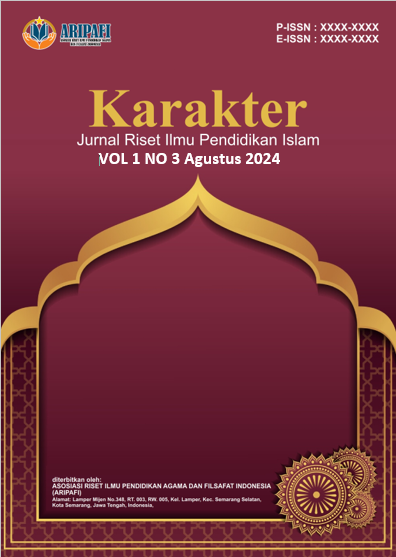Pengaruh Metode Pembelajaran Problem Solving Terhadap Hasil Belajar Siswa Pada Mata Pelajaran Sejarah Kebudayaan Islam
DOI:
https://doi.org/10.61132/karakter.v1i3.355Keywords:
Problem Solving Method, Learning outcomesAbstract
This research aims to determine the influence of applying problem solving learning methods on student learning outcomes in the class X Islamic Cultural History subject. The type of research used is quantitative research using a Pre-Experimental design (one-group-pretest-posttest Design). The population in this study was 253 and the sample in this study was 53. The sampling technique used by researchers was Cluster Sampling. The research results obtained based on the results of the paired samples t-test analysis obtained a sig value. (2-tailed) of 0.000 with a significance level of α=0.05, which means 0.000 <0.05, so Ha is accepted and Ho is rejected. Meanwhile, it is known that the data df=31, the significance level α=0.05, the t-count value = 24.002 and the t-table = 2.021 so it can be stated that the t-count value is greater than the t-table meaning 24.002>2.021 with a correlation level of 0.960 . So Ha is accepted and Ho is rejected, meaning the influence of problem solving learning methods on student learning outcomes in SKI subjects in class is -0.041 (experimental class posttest = 84.84 and control class posttest = 59.05) which means the average score for the experimental class posttest is higher than the control class posttest. Thus it can be concluded that the problem solving method influences student learning outcomes in the SKI class X MAN 3 Banyuwangi subject.
References
Amalia, S. (2018). Penggunaan Metode Problem Solving Dalam Pengembangan Aspek Kognitif Pada Mata Pelajaran PAI Siswa Kelas VIII SMPN 2 Way Pengubuan Lampung Tengah. Skripsi. Lampung: Institut Agama Islam Negeri Metro.
As’adi, M. (2023). Pengaruh Kesejahteraan Guru Dan Komitmen Organisasi Terhadap Kinerja Guru Pada MTS Nahdlatuth Thullaab Kecamatan Licin. Jurnal Ilmu Pendidikan dan Sosial, 1(4), 374-380.
Fitria, M., & Slamet, S. (2024). Upaya Kepala Madrasah dalam Meningkatkan Profesionalisme Guru. Jurnal Manajemen dan Pendidikan Agama Islam, 2(6), 404-415.
Hamiyah, N & Jauhar, M. (2014). Strategi Belajar Mengajar di Kelas. Jakarta: Prestasi Pustakarya.
Mishra, L., Gupta, T., & Shree, A. (2020). Online teaching-learning in higher education during lockdown period of COVID-19 pandemic. International journal of educational research open, 1, 100012.
Oleson, A., & Hora, M. T. (2014). Teaching the way they were taught? Revisiting the sources of teaching knowledge and the role of prior experience in shaping faculty teaching practices. Higher education, 68, 29-45.
Ramayulis. (2015). Ilmu Pendidikan Islam. Jakarta: Kalam Mulia.
Saefuddin, A. & Berdiati, I. (2014). Pembelajaran Efektif. Bandung: PT Remaja Rosdakarya.
Sugiyono. (2020). Metode Penelitian Kuantitatif Kualitatif dan R&D. Edisi kedua. Bandung: Alfabeta.
Suhendri. (2015). Pengaruh Pengetahuan, Tarif Pajak, Dan Sanksi Pajak Terhadap Kepatuhan Wajib Pajak Orang Pribadi Yang Melakukan Kegiatan Usaha Dan Pekerjaan Bebas Di Kota Padang (Studi Empiris Pada Kantor Pelayanan Pajak Pratama Kota Padang. Tesis. Universitas Negeri Padang.
Undang-undang Republik Indonesia No. 20 Tahun 2003 Tentang Sistem Pendidikan Nasional Bab 1
Wahyuningtyas, dkk. (2019). Penelitian Tindakan Kelas dan Pengembangan Profesionalisme Guru Sekolah Dasar. Yogyakarta: Sanata Dharma University Press.
Wartini, I., Mangkuwibawa, H., & Anwar, C. (2018). Penerapan Metode Problem Solving Untuk Meningkatkan Pemahaman Matematika. Al-Aulad: Journal of Islamic Primary Education, 1(2).






